Developers
API References
Data Subject Request API
Data Subject Request API Version 1 and 2
Data Subject Request API Version 3
Platform API
Key Management
Platform API Overview
Accounts
Apps
Audiences
Calculated Attributes
Data Points
Feeds
Field Transformations
Services
Users
Workspaces
Warehouse Sync API
Warehouse Sync API Overview
Warehouse Sync API Tutorial
Warehouse Sync API Reference
Data Mapping
Warehouse Sync SQL Reference
Warehouse Sync Troubleshooting Guide
ComposeID
Warehouse Sync API v2 Migration
Bulk Profile Deletion API Reference
Calculated Attributes Seeding API
Custom Access Roles API
Group Identity API Reference
Data Planning API
Pixel Service
Profile API
Events API
mParticle JSON Schema Reference
IDSync
Client SDKs
AMP
AMP SDK
Android
Initialization
Configuration
Network Security Configuration
Event Tracking
User Attributes
IDSync
Screen Events
Commerce Events
Location Tracking
Media
Kits
Application State and Session Management
Data Privacy Controls
Error Tracking
Opt Out
Push Notifications
WebView Integration
Logger
Preventing Blocked HTTP Traffic with CNAME
Linting Data Plans
Troubleshooting the Android SDK
API Reference
Upgrade to Version 5
Cordova
Cordova Plugin
Identity
Direct Url Routing
Direct URL Routing FAQ
Web
Android
iOS
iOS
Workspace Switching
Initialization
Configuration
Event Tracking
User Attributes
IDSync
Screen Tracking
Commerce Events
Location Tracking
Media
Kits
Application State and Session Management
Data Privacy Controls
Error Tracking
Opt Out
Push Notifications
Webview Integration
Upload Frequency
App Extensions
Preventing Blocked HTTP Traffic with CNAME
Linting Data Plans
Troubleshooting iOS SDK
Social Networks
iOS 14 Guide
iOS 15 FAQ
iOS 16 FAQ
iOS 17 FAQ
iOS 18 FAQ
API Reference
Upgrade to Version 7
React Native
Getting Started
Identity
Unity
Upload Frequency
Getting Started
Opt Out
Initialize the SDK
Event Tracking
Commerce Tracking
Error Tracking
Screen Tracking
Identity
Location Tracking
Session Management
Web
Initialization
Configuration
Content Security Policy
Event Tracking
User Attributes
IDSync
Page View Tracking
Commerce Events
Location Tracking
Media
Kits
Application State and Session Management
Data Privacy Controls
Error Tracking
Opt Out
Custom Logger
Persistence
Native Web Views
Self-Hosting
Multiple Instances
Web SDK via Google Tag Manager
Preventing Blocked HTTP Traffic with CNAME
Facebook Instant Articles
Troubleshooting the Web SDK
Browser Compatibility
Linting Data Plans
API Reference
Upgrade to Version 2 of the SDK
Xamarin
Getting Started
Identity
Alexa
Quickstart
Android
Overview
Step 1. Create an input
Step 2. Verify your input
Step 3. Set up your output
Step 4. Create a connection
Step 5. Verify your connection
Step 6. Track events
Step 7. Track user data
Step 8. Create a data plan
Step 9. Test your local app
iOS Quick Start
Overview
Step 1. Create an input
Step 2. Verify your input
Step 3. Set up your output
Step 4. Create a connection
Step 5. Verify your connection
Step 6. Track events
Step 7. Track user data
Step 8. Create a data plan
Python Quick Start
Step 1. Create an input
Step 2. Create an output
Step 3. Verify output
Server SDKs
Node SDK
Go SDK
Python SDK
Ruby SDK
Java SDK
Guides
Partners
Introduction
Outbound Integrations
Outbound Integrations
Firehose Java SDK
Inbound Integrations
Compose ID
Data Hosting Locations
Glossary
Migrate from Segment to mParticle
Migrate from Segment to mParticle
Migrate from Segment to Client-side mParticle
Migrate from Segment to Server-side mParticle
Segment-to-mParticle Migration Reference
Rules Developer Guide
The Developer's Guided Journey to mParticle
API Credential Management
Guides
Customer 360
Overview
User Profiles
Overview
User Profiles
Group Identity
Overview
Create and Manage Group Definitions
Calculated Attributes
Calculated Attributes Overview
Using Calculated Attributes
Create with AI Assistance
Calculated Attributes Reference
Predictive Attributes
What are predictive attributes?
Getting Started
Create an Input
Start capturing data
Connect an Event Output
Create an Audience
Connect an Audience Output
Transform and Enhance Your Data
Platform Guide
Billing
Usage and Billing Report
The New mParticle Experience
The new mParticle Experience
The Overview Map
Observability
Observability Overview
Observability User Guide
Observability Troubleshooting Examples
Observability Span Glossary
Platform Settings
Key Management
Event Forwarding
Notification Center (Early Access)
System Alerts
Trends
Introduction
Data Retention
Data Catalog
Connections
Activity
Data Plans
Live Stream
Filters
Rules
Blocked Data Backfill Guide
Tiered Events
mParticle Users and Roles
Analytics Free Trial
Troubleshooting mParticle
Usage metering for value-based pricing (VBP)
Segmentation
New Audiences Experience
Audiences Overview
Create an Audience
Connect an Audience
Manage Audiences
FAQ
Classic Audiences Experience
Real-time Audiences (Legacy)
Standard Audiences (Legacy)
New vs. Classic Experience Comparison
Predictive Audiences
Predictive Audiences Overview
Using Predictive Audiences
IDSync
IDSync Overview
Use Cases for IDSync
Components of IDSync
Store and Organize User Data
Identify Users
Default IDSync Configuration
Profile Conversion Strategy
Profile Link Strategy
Profile Isolation Strategy
Best Match Strategy
Aliasing
Analytics
Introduction
Core Analytics (Beta)
Setup
Sync and Activate Analytics User Segments in mParticle
User Segment Activation
Welcome Page Announcements
Settings
Project Settings
Roles and Teammates
Organization Settings
Global Project Filters
Portfolio Analytics
Analytics Data Manager
Analytics Data Manager Overview
Events
Event Properties
User Properties
Revenue Mapping
Export Data
UTM Guide
Analyses
Analyses Introduction
Segmentation: Basics
Getting Started
Visualization Options
For Clauses
Date Range and Time Settings
Calculator
Numerical Settings
Segmentation: Advanced
Assisted Analysis
Properties Explorer
Frequency in Segmentation
Trends in Segmentation
Did [not] Perform Clauses
Cumulative vs. Non-Cumulative Analysis in Segmentation
Total Count of vs. Users Who Performed
Save Your Segmentation Analysis
Export Results in Segmentation
Explore Users from Segmentation
Funnels: Basics
Getting Started with Funnels
Group By Settings
Conversion Window
Tracking Properties
Date Range and Time Settings
Visualization Options
Interpreting a Funnel Analysis
Funnels: Advanced
Group By
Filters
Conversion over Time
Conversion Order
Trends
Funnel Direction
Multi-path Funnels
Analyze as Cohort from Funnel
Save a Funnel Analysis
Explore Users from a Funnel
Export Results from a Funnel
Saved Analyses
Manage Analyses in Dashboards
Query Builder
Data Dictionary
Query Builder Overview
Modify Filters With And/Or Clauses
Query-time Sampling
Query Notes
Filter Where Clauses
Event vs. User Properties
Group By Clauses
Annotations
Cross-tool Compatibility
Apply All for Filter Where Clauses
Date Range and Time Settings Overview
User Attributes at Event Time
Understanding the Screen View Event
User Aliasing
Dashboards
Dashboards––Getting Started
Manage Dashboards
Dashboard Filters
Organize Dashboards
Scheduled Reports
Favorites
Time and Interval Settings in Dashboards
Query Notes in Dashboards
Analytics Resources
The Demo Environment
Keyboard Shortcuts
User Segments
Warehouse Sync
Data Privacy Controls
Data Subject Requests
Default Service Limits
Feeds
Cross-Account Audience Sharing
Approved Sub-Processors
Import Data with CSV Files
Import Data with CSV Files
CSV File Reference
Glossary
Video Index
Analytics (Deprecated)
Identity Providers
Single Sign-On (SSO)
Setup Examples
Introduction
Developer Docs
Introduction
Integrations
Introduction
Rudderstack
Google Tag Manager
Segment
Data Warehouses and Data Lakes
Advanced Data Warehouse Settings
AWS Kinesis (Snowplow)
AWS Redshift (Define Your Own Schema)
AWS S3 Integration (Define Your Own Schema)
AWS S3 (Snowplow Schema)
BigQuery (Snowplow Schema)
BigQuery Firebase Schema
BigQuery (Define Your Own Schema)
GCP BigQuery Export
Snowflake (Snowplow Schema)
Snowplow Schema Overview
Snowflake (Define Your Own Schema)
Developer Basics
Aliasing
Integrations
Aarki
Audience
Abakus
Event
24i
Event
ABTasty
Audience
AdChemix
Event
Actable
Feed
AdMedia
Audience
Adobe Marketing Cloud
Cookie Sync
Server-to-Server Events
Platform SDK Events
Adobe Audience Manager
Audience
Adobe Campaign Manager
Audience
Adobe Target
Audience
AdPredictive
Feed
AgilOne
Event
Algolia
Event
Amazon Advertising
Audience
Alooma
Event
Amazon Kinesis
Event
Amazon Redshift
Data Warehouse
Amazon S3
Event
Amazon SQS
Event
Amazon SNS
Event
Amobee
Audience
Anodot
Event
Antavo
Feed
Apptentive
Event
Apptimize
Event
Apteligent
Event
Awin
Event
Attractor
Event
Microsoft Azure Blob Storage
Event
Bidease
Audience
Bluecore
Event
Bing Ads
Event
Bluedot
Feed
Branch S2S Event
Event
Cadent
Audience
Bugsnag
Event
Census
Feed
comScore
Event
Conversant
Event
Custom Feed
Custom Feed
Crossing Minds
Event
Datadog
Event
Databricks
Data Warehouse
Dynalyst
Audience
Didomi
Event
Edge226
Audience
Emarsys
Audience
Epsilon
Event
Facebook Offline Conversions
Event
Flurry
Event
Everflow
Audience
Google Analytics for Firebase
Event
Flybits
Event
ForeSee
Event
FreeWheel Data Suite
Audience
Friendbuy
Event
Google Ad Manager
Audience
Google Analytics
Event
Google Analytics 4
Event
Google BigQuery
Data Warehouse
Audience
Google Enhanced Conversions
Event
Google Marketing Platform Offline Conversions
Event
Google Marketing Platform
Audience
Cookie Sync
Event
Google Pub/Sub
Event
Google Tag Manager
Event
Heap
Event
Herow
Feed
Hyperlocology
Event
Hightouch
Feed
Ibotta
Event
Impact
Event
ID5
Kit
InMarket
Audience
Inspectlet
Event
Intercom
Event
ironSource
Audience
Kissmetrics
Event
Kafka
Event
LaunchDarkly
Feed
Kubit
Event
LifeStreet
Audience
Localytics
Event
LiveLike
Event
Liveramp
Audience
MadHive
Audience
mAdme Technologies
Event
Marigold
Audience
MediaMath
Audience
Mediasmart
Audience
Microsoft Azure Event Hubs
Event
Mintegral
Audience
Monetate
Event
Movable Ink - V2
Event
Movable Ink
Event
Nami ML
Feed
Nanigans
Event
Multiplied
Event
NCR Aloha
Event
Neura
Event
OneTrust
Event
Oracle BlueKai
Event
Paytronix
Feed
Persona.ly
Audience
Personify XP
Event
Plarin
Event
Quadratic Labs
Event
Qualtrics
Event
Quantcast
Event
Rakuten
Event
Regal
Event
Reveal Mobile
Event
RevenueCat
Feed
Salesforce Mobile Push
Event
Salesforce Sales and Service Cloud
Event
Scalarr
Event
Shopify
Custom Pixel
Feed
Signal
Event
SimpleReach
Event
Skyhook
Event
Singular-DEPRECATED
Event
Slack
Event
Smadex
Audience
SmarterHQ
Event
Snapchat Conversions
Event
Snowflake
Data Warehouse
Snowplow
Event
Splunk MINT
Event
StartApp
Audience
Talon.One
Audience
Event
Feed
Loyalty Feed
Tapad
Audience
Tapjoy
Audience
Taplytics
Event
Taptica
Audience
Teak
Audience
The Trade Desk
Audience
Cookie Sync
Event
Ticketure
Feed
Triton Digital
Audience
TUNE
Event
Valid
Event
Vkontakte
Audience
Webtrends
Event
Vungle
Audience
Webhook
Event
White Label Loyalty
Event
Wootric
Event
Xandr
Cookie Sync
Audience
Yahoo (formerly Verizon Media)
Audience
Cookie Sync
Yotpo
Feed
YouAppi
Audience
Primer
Event
Tiered Events
mParticle collects data from all of your platforms and data connections and uses it to resolve customer identities and stitch together customer profiles. It also makes this data available to be forwarded to downstream systems, and retains it in long-term data stores that allow you to run data replays with help from mParticle Support.
By default, mParticle makes all data available for evaluation. However, many events and the data related to them may not be needed for running data replays or evaluations depending on how you use Audiences or Calculated Attributes. With Tiered Events, you can choose to collect data but not store it, or to collect and store data but not evaluate it.
These configurations help improve performance for all customers, and may provide cost savings for value-based pricing customers.
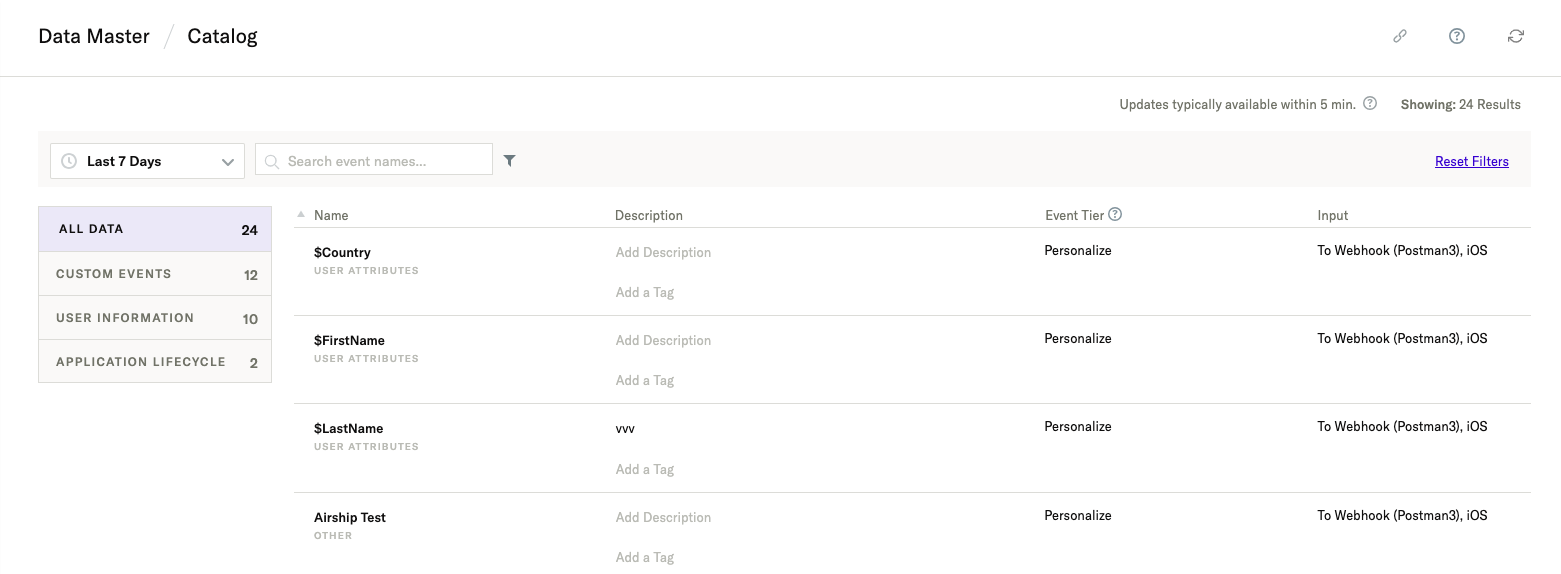
mParticle provides three event tiers. All three tiers support ingestion and forwarding of data, but provide different levels of support for storage and evaluation:
- Connect: Data is not stored in mParticle, but can be ingested and forwarded. The data is also used for profile enrichment. Because Connect tier events aren’t stored, they won’t be visible in the User Activity view.
- Preserve: Events marked as Preserve are ingested, stored, and forwarded but are not used in real-time evaluations for audiences or calculated attributes. The data is still available for replaying to third party tools, and for backfills of calculated attributes and standard audience creation.
- Personalize: This tier is the default for all events and related data collected as part of an mParticle ingestion. Events are ingested, available for evaluation in audiences and calculated attributes, stored, and forwarded.
The following table can help you decide which tier to apply to data:
Feature |
Personalize | Preserve | Connect |
|---|---|---|---|
| Event data | ✓ | ✓ | ✓ |
| Profile enrichment | ✓ | ✓ | ✓ |
| Ingest | ✓ | ✓ | ✓ |
| Forward | ✓ | ✓ | ✓ |
| Store for data replays and backfills | ✓ | ✓ | |
| Evaluate for calculated attributes | ✓ | ||
| Evaluate for real-time audience | ✓ |
If your account uses value-based pricing, you can change the default event tier for ingested events.
Manage your event tiers
There are two ways to modify your event tiers:
- Individually through the mParticle UI
- In bulk by modifying a CSV formatted Event Volume Report
Prerequisites
Before you modify your event tiers using either method, ensure the following prerequisites are met:
- You must have the Admin and Compliance role to change event tiers for an event type. All other data will behave as if on the Personalize tier.
-
Verify that the consequences of changing tiers are acceptable in your environment:
- Event marked Preserve are never available for real-time evaluation, only for data replay or backfills.
- Events marked Connect are not available for data replays, backfills or real-time evaluation. These events are not visible in the User Activity View.
- Only events, including custom events, screen views, commerce events, and application lifecycle events, can be assigned an event tier. User information can’t be assigned a tier and so is only in the Personalize tier.
Modify an event tier in the UI
To change the event tier using the UI:
- Navigate to Data Platform > Data Catalog and select the event type such as Custom Events or Screen View.
- Next to the event, click the Event Tier drop-down and select a new tier.
- Click Apply.
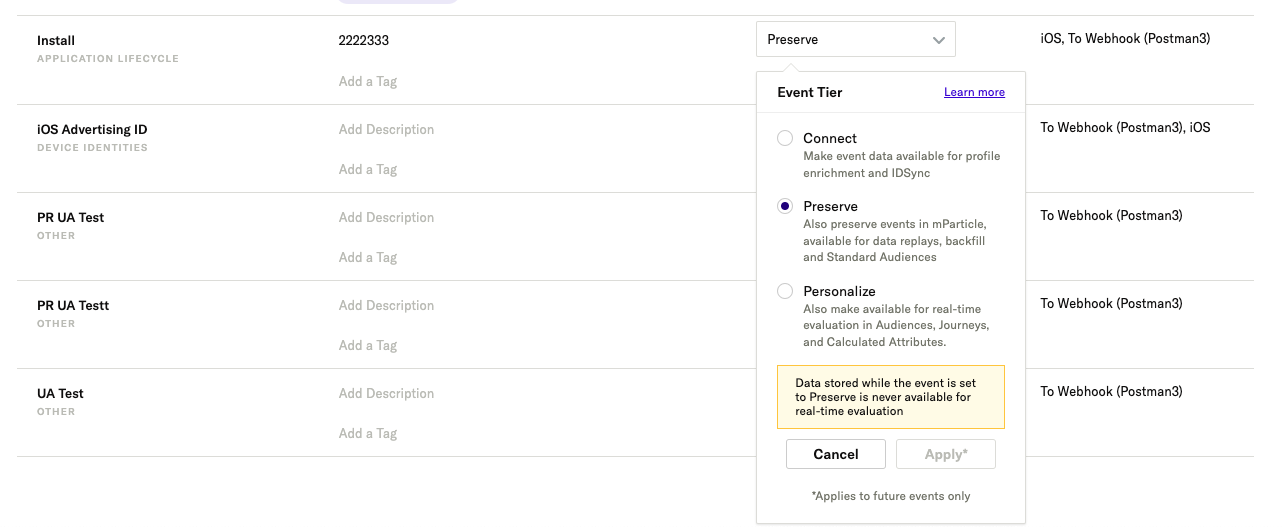
Modify event tiers in bulk
You can make bulk modifications to your event tiers by downloading a copy of your Event Volume Report, entering your new tiers in the New Event Tier column in the downloaded file, and then re-uploading your new report to commit your changes in mParticle.
To make bulk changes to your event tiers:
- Navigate to Data Platform > Data Catalog and hover your cursor over the Event Tier tooltip.
- Click Manage Event Tiers.
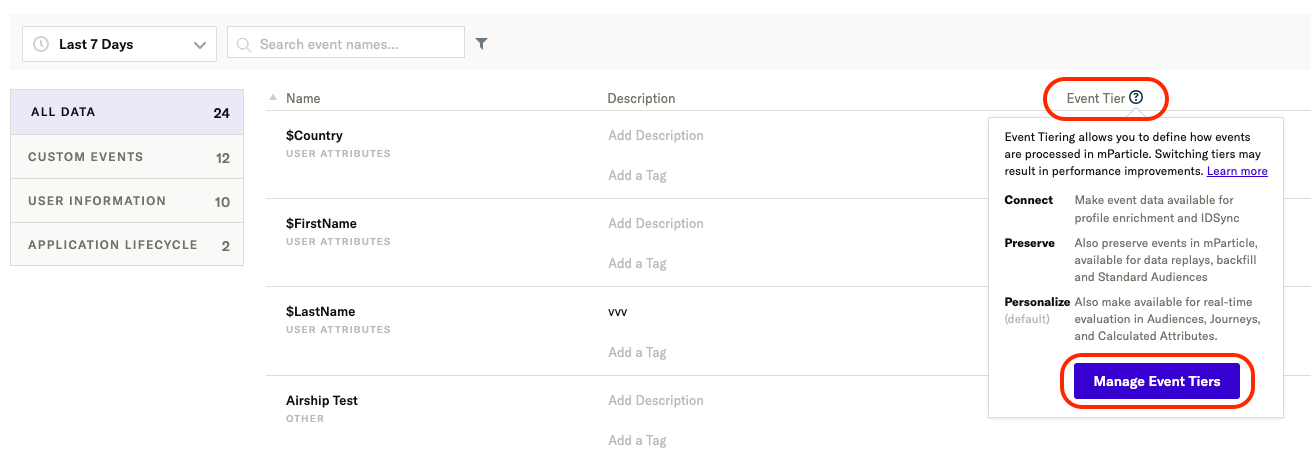
- Select Download Event Volume Report and click Next.
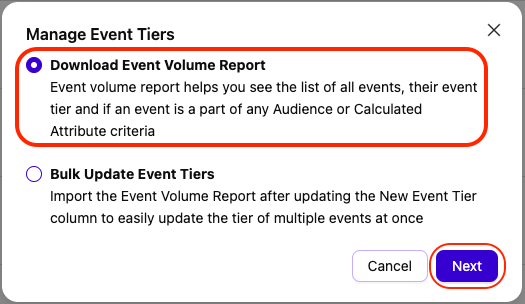
-
Under Select Event Volume Data Range, use the date picker to select one of the date range presets or enter a specific date range to include in your Event Volume Report.
- Regardless of the date range you select for your report, it will represent every event type that mParticle has ingested for your account. The date range selection simply allows you to view the relative volume of events ingested for each type within a specific timeframe.
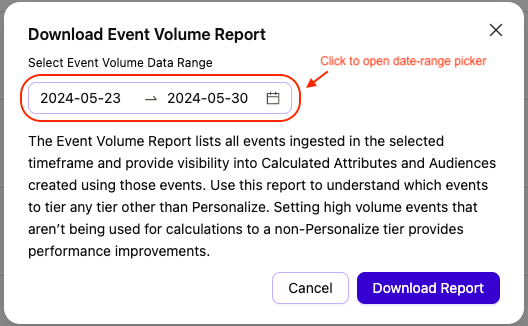
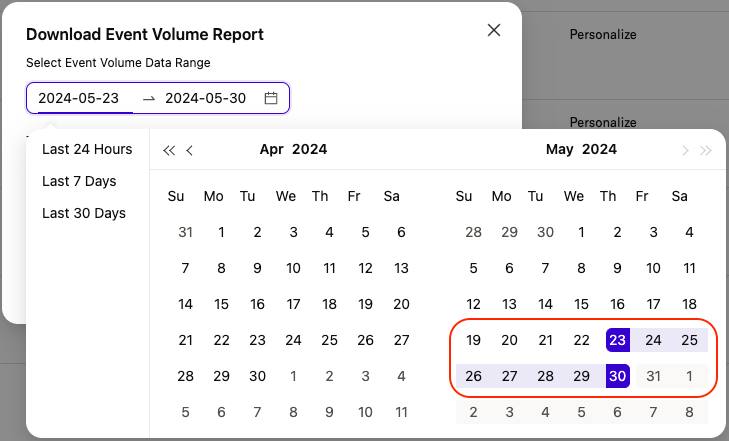
- After entering the date range of the event data you want included in your report, click Download Report.
-
Open the Event Volume Report downloaded to your computer. Find the row for each event type you want to change the tier for, and enter the tier in the New Event Tier column. Make sure to save your changes.
- Remember, the three event tiers are
Connect,PreserveandPersonalize.
- Remember, the three event tiers are

- To upload your modified report, repeat steps 1-2, select Bulk Update Event Tiers, and click Next.

- In the Bulk Update Event Tiers modal, click Upload and select your modified Event Volume Report.
- Click Update Event Tiers to upload your modified Event Volume Report. When the upload is complete, a new Event Volume Report is automatically generated and downloaded to your computer so you can confirm that your changes were made correctly.
Change the default event tier
By default, mParticle assigns all event types to the Personalize tier. However, you can change the default assignment to Preserve or Connect if your account uses value-based pricing.
Changing the default tier is helpful. For example, if you create a data plan with many new event types and most of them won’t be needed for real-time evaluations, you could assign them to the Preserve or Connect tier by default.
To change the default event tier for a workspace:
- In the left-hand navigation, click the Settings gear cog to open the settings menu.
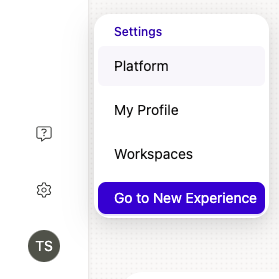
- Click Workspaces.
- From the list of workspaces, click a workspace name to open the workspace settings dialog.

- Expand Defaults and use the drop-down in the Event Tiers section to choose a new default tier.
- Click Save to save your changes.
After you set a default tier, all new events of all types seen in mParticle are assigned the new default tier. You can override the default tier assignment of an event type in Data Platform > Data Catalog.
For example, you could change the default tier to Connect in the workspace setting and also set the tier for event type MyEvent to Personalize. Then, all new and existing events of type MyEvent are assigned the Personalize tier, while all other new events are given the new default, Connect.
Event Volume Report
The event volume report is a CSV file that lists all the events used in calculated attributes and audiences. It also shows data volumes for the time range you specify.
The event volume report is accessible from your workspace settings:
- Hover your cursor over the Settings gear icon in the left hand nav and click Workspaces.
- Click the Event Volume Report button in the upper right.
- Select the date range for the data you want covered in your report, then click Download Report.

The Event Volume Report displays an approximate count of each event type ingested from your inputs within a certain date range. You can use these metrics to identify event types to change to a different event tier, or event types to exclude from calculated attributes and audience definitions.
Event Volume Report and value-based pricing
There are differences between the Event Volume Report and your Monthly Credit Usage Report, which is a record of the billable items you are charged for. To learn how billable items are calculated, see Usage metering for value-based pricing (VBP).
The two reports present different views of your data ingestion:
- The Monthly Credit Usage Report provides a retrospective view of the services your account is charged for according to the billing logic documented in Usage metering for value-based pricing.
- The Event Volume Report provides a view of how data is being ingested at the time the report is generated, and should be used to help you select your event tier assignments.
Differences between the Event Volume Report and Monthly Credit Usage Report
Following is a list of differences between the Event Volume Report and Monthly Credit Usage Report:
- The Event Volume Report doesn’t include events added or dropped as a result of Rules, but those events are included in the Credit Usage Report.
-
The Event Volume Report displays event tier assignments at the time the report is generated, but the Credit Usage Report displays event tier assignments for events at the time they were ingested and processed. For example, imagine the following scenario:
- Day 1 of your billing period: you ingest one million events with the
Screen Viewevent type in theConnectevent tier. - Day 5 of your billing period: you change the event tier for
Screen ViewfromConnecttoPreserveand you ingest another one million events. - Day 6 of your billing period: you download your Event Volume Report and see two million
Screen Viewevents in thePreserveevent tier. However, your Credit Usage Report will show one million events in theConnecttier and one million events in thePreservetier.
- Day 1 of your billing period: you ingest one million events with the
- The Event Volume Report includes automatically generated events like the
batch.SystemNotifications, which could include events likeConsentGrantedandConsentDenied. However, automatically generated events are not included in the Monthly Credit Report, because they are not billable items. - If you download an Event Volume Report before a batch of events is processed, they will not be reflected in the Event Volume Report, but they will be reflected in the Credit Usage Report.
-
Events timestamped 72 hours prior to when they are ingested are not be reflected in the Event Volume Report.
- For example: Imagine that on February 24, 2022 at 11:00 UTC, you ingest an event that is timestamped at
February 21, 2022 at 10:00 UTC. An Event Volume Report report created on February 21st will not reflect that event. However, it will be reflected in your Monthly Credit Report.
- For example: Imagine that on February 24, 2022 at 11:00 UTC, you ingest an event that is timestamped at
Was this page helpful?
- Last Updated: July 1, 2025